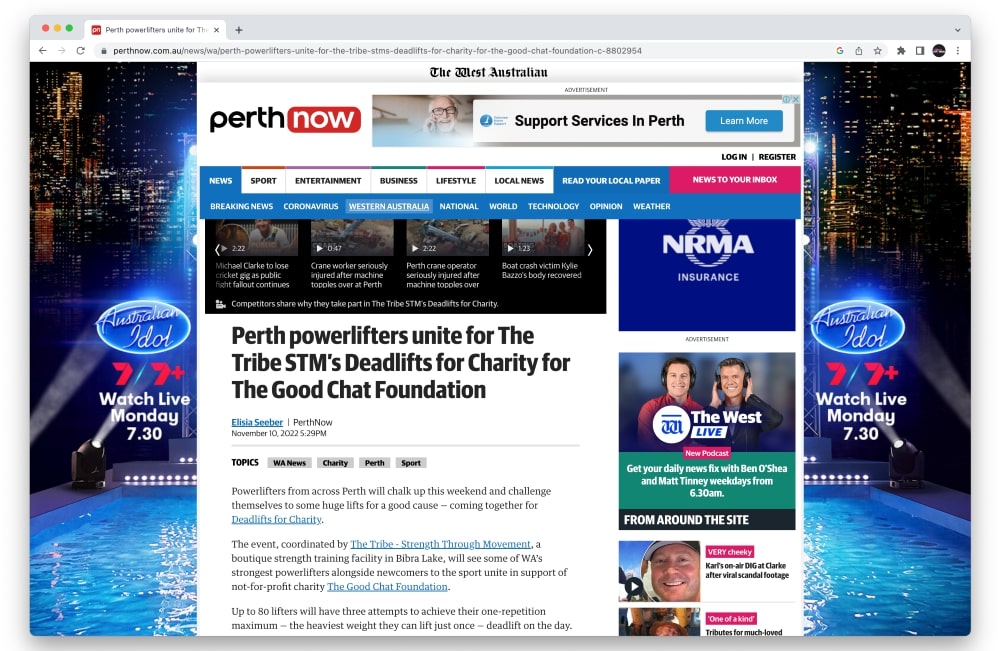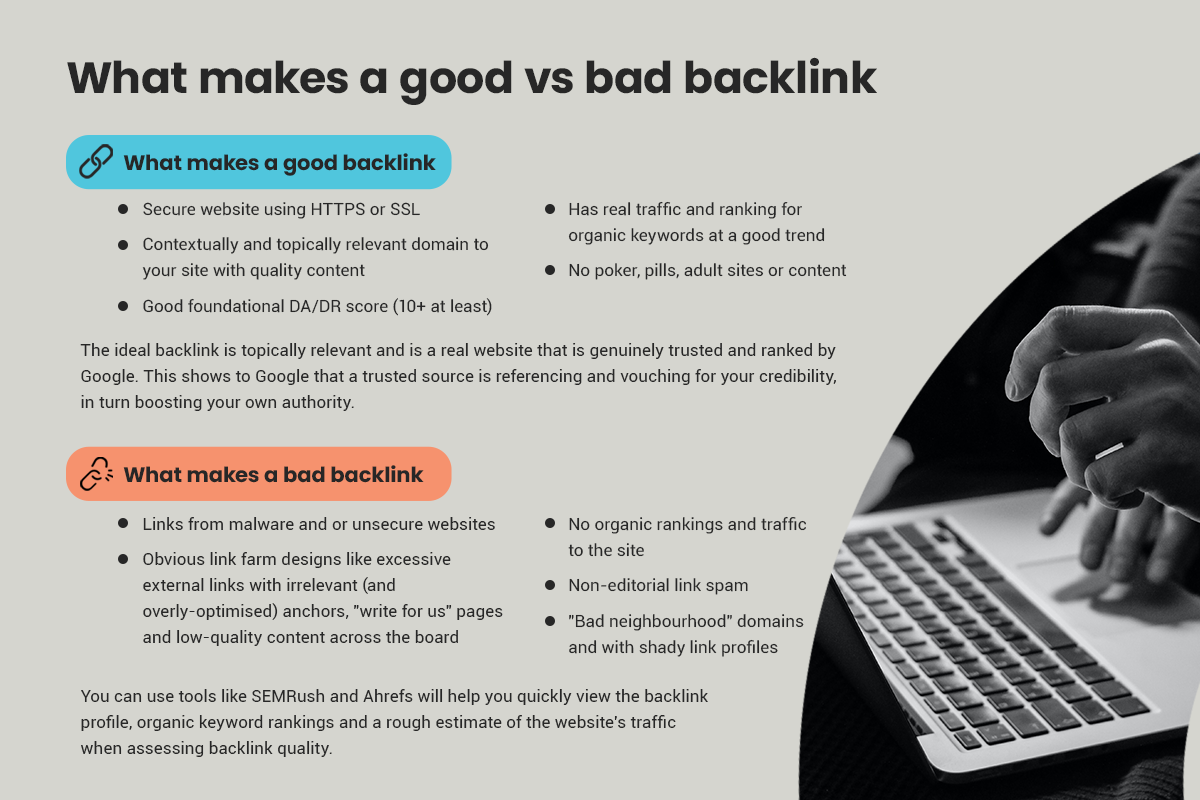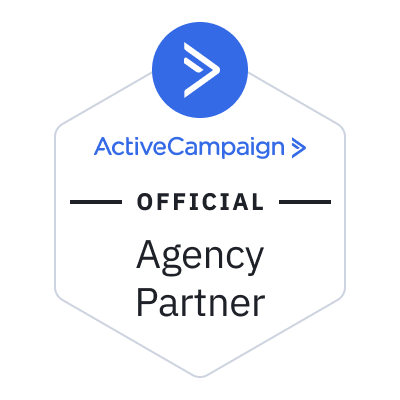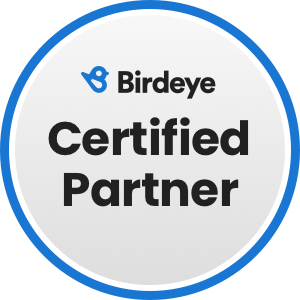Undeniably, backlinks are core to search rankings and showing up on the top of Google. It’s also a side of SEO rife with shady practices and vendors built to game the search algorithm.
Google makes no secret that certain links and link-building practices are frowned upon, but what makes a backlink good for your website, and which should you avoid?
In this blog post, we’ll cover how to distinguish between good and bad backlinks in your link profile and how you can use that information to clean up and strengthen your site’s authority and reach higher positions in rank.
What is a backlink profile?
If a backlink is a link from one website to another, a backlink profile is the total number of links that all point to your site. Google uses these as a means for measuring the authority of a page or website, which influences how you show up at SERPs.
With tons of quality links in your profile, Google recognises your site is trustworthy and authoritative. Enough that other websites would like to cite you as a source of credible information and as an authority in your niche.
And the more authoritative a website appears to Google, the higher the likelihood of showing up higher in SERPs is.
Why not all backlinks are made equal
In theory, using backlinks to measure “authority” makes sense. If you are an expert in your field or produce good content that people cite and reference, then backlinks can work as a metric. The more others reference you, the more credible you seem.
In practice, it’s a bit of a different story.
The issue comes in what “counts” as a backlink because a lot can be considered one.
For example, commenting on someone else’s blog post. It could be counted as a link on a website relevant to your niche (if it is), and there’s a link there that points to your site there. Or commenting on a forum in a similar niche to yours. That’s technically a backlink from a “relevant” domain to your site.
Back in the wild west of the internet before certain algorithm updates were in place, spammy blog comments and forum posts were commonplace. Eventually, these practices were penalised, but this made it so that now certain types of links were devalued, and didn’t count towards a website’s authority.
And even then other practices like purchasing backlinks or low-quality guest posts on content farms, mass content syndication to hundreds of different sites (that are now all supposed to be set as no follow links), and shady private blog networks were all also used to manipulate search results.
To that end, Google continuously rolls out updates that devalue certain links and practices:
- Google Panda update: content farms that churn out low-quality content and produce links en masse are devalued in favour of higher-quality content and are pushed lower in SERPs
- Google Penguin update: websites that use blackhat SEO practices and unnatural or black hat link building is more easily identified, ignored (devalued) and penalised
- Google helpful content update: AI content, unoriginal content that only recycles existing information and content that are shallow are further devalued
- And now the recent December 2022 link spam update: which allows Google to use AI through their SpamBrain algorithm to automatically identify backlinks that come from sites that look like they sell links/or are made to sell backlinks and neutralise their backlink value
Google wants top-quality content to show up at the top of search results, and authority and reputation matter. And practices that were exploitable could lead to bad content getting to the top of SERPs, which isn’t something Google wants.
What makes a good vs bad backlink
Before you take a look into your link profile to find out if it’s strong or not, you’ll need to know what makes a good vs bad backlink.
What makes a good backlink
A good backlink is any link pointing to your site that shows you have authority. Generally, a good backlink comes from authoritative sites, relevant to their niche. By having trusted sources cite your information, Google uses this to know that your site has helpful, valuable and quality content worth sharing and promoting.
This is why having more good backlinks in your link profile becomes beneficial. The more you are seen as a source of valuable information, the more authoritative you seem in your niche. And the more likely you are to be pushed higher in search results.
An example of a good backlink: On a high DA/DR website, with good traffic, content relevant to the target site and the anchor text for The Tribe STM is naturally placed.
You can tell a backlink is of good quality if they have these key points:
- A minimum DA/DR of at least 10-20+ as a baseline measure to see if the domain is “good”
- The link comes from a site or page that is contextually and topically relevant to you (the niche, geographically, etc. the more specific the better)
- The domain of the site uses HTTPS or SSL
- Has real traffic coming into it, and a bonus if the traffic is trending upward (use tools such as Ahrefs or Semrush to check)
- No poker, pills, adult sites or content (content that often uses spammy tactics attached to them if they want to get traffic)
- The anchor text is not overly optimised and can be read naturally within the content
What makes a bad backlink
In general, Google considers a bad backlink to be any backlink built from shady, black hat practices that violate Google’s guidelines or come from an untrustworthy source. These are typically links that are artificially made, paid for and built to manipulate rankings; which Google is explicitly against.
Having toxic links in your link profile does nothing but leave you open to being penalised. And even if you do benefit, the value quickly becomes moot as Google has historically (and continuously) shown to update its algorithms to better devalue and punish these links.
Examples of bad backlinks to avoid and remove from your link profile
- Backlinks from link schemes
- Non-editorial link spam
- Links from bad neighbourhood websites
- Malware links
- Links with aggressively keyword-optimised anchor text
Backlinks From Link Schemes, Content Farms or Any Other Negative Seo Attack.
These are the links that if you get penalised, will be pointed out as an example by Google. Blackhat PBNs, low-quality and spammy guest post sites or link farms to name a few.
There are tools like Ahrefs and Semrush that you can use to identify if it’s a link scheme or not, but you can always use a manual check. Does the website have a broad range of content? Are there way too many links in each blog post (that might fit unnaturally in the context of the blog)? Is there no author for the post? If they tick those boxes, those are common signals for these types of practices.
Non-editorial Link Spam (From Forum Signatures, Blog Comment Spam, Etc.)
Spammy blog and forum comment, and although they have since been devalued you can still see these practices when you snoop around the web. You can find the whole list of non-editorial links from Google’s documentation, but generally, these are ones to avoid and remove.
Links From Bad Neighbourhood Websites
A “bad neighbourhood” website is any website that has content and/or backlinks from sites with pills, gambling or adult content. In the same way, you don’t want to associate your site or business with shady places, you want to remove links from shady places like those as well.
Malware Links
These should be pretty familiar. Links that’ll make pop-ups, freeze your computer and give you a red browser warning if you try and open them. To verify and check for these types of links, you’ll have to do them manually but you can use a tool like Transparency Report to make sure you’re safe while doing so.
Links With Shady or Aggressively Keyword-heavy Anchor Text
Any money or overly optimised anchors are understood by Google as an attempt to manipulate PageRank. Links with these don’t happen naturally, and this makes it looks like it’s built to game Google’s system.
Practical use of knowing how to identify and distinguish backlinks
Simply knowing the difference between good and bad links is just half of it. The other is in knowing what to do with that information to better your link profile.
By knowing the difference between good vs bad backlinks, you will be able to know:
- Which bad backlinks to remove to clean up your link profile
- What good backlinks do you want to aim for to strengthen your authority
How to remove bad backlinks and clean up a backlink profile
There are two ways you can “remove” bad backlinks from your profile and affect your site’s authority. By outreaching and asking for the links to be manually removed, or by submitting a list of bad backlinks for Google to disavow.
Step 1: Finding toxic backlinks to remove
Third-party tools like Semrush offers functions that can find toxic backlinks for you, but if you have no access to them, you can find them yourself.
You can do this by using Google Search Console from the “Links” tab on the left sidebar towards the bottom. From there, you’ll need to search and identify all the toxic links pointing to your site.
If you’ve got a manual penalty, Google will give you a list of some of the backlinks that got you penalised, for example. These won’t be the full list of links that got you penalised, but it does help you get started and give you an idea of what to look out for.
Otherwise, refer to the earlier examples for what types of bad links to target.
Keep in mind that you don’t want to disavow every low-quality backlink in your profile. Backlinks from lower-quality (but non-toxic) domains, scrapers and feeds automatically generated by bots are natural and expected. After all, it isn’t realistic to spend any amount of time living on the internet without hitting junk at some point.
Trust that Google’s algorithm is smart enough to ignore harmless low-quality links and avoid accidentally removing links that helped you (if even a little, very tiny bit).
Step 2: Removing or disavowing the list of toxic links with Google’s disavow tool
Before you disavow your backlinks, try reaching out to the backlink’s site owners and asking for the link to be removed. If unsuccessful, then disavowing becomes an option.
Disavowing a backlink means Google will disassociate that backlink from your website.
Important note: Disavowing is recommended if a) you’ve been hit by a penalty or b) you’ve taken a look at your link profile and found that you may be vulnerable. This tool is hidden for a reason; if you’re not careful you might accidentally take out helpful links
After you’ve compiled your list of backlinks to disavow, the next step is to put that into a disavow file.
Using a .txt file editor (e.g. Text Edit or Notepad), paste the URLs (with one URL per each line) if you would like to disavow a URL or paste with “domain:” prefix if you would like to disavow an entire domain.
Do this for every URL you need to disavow.
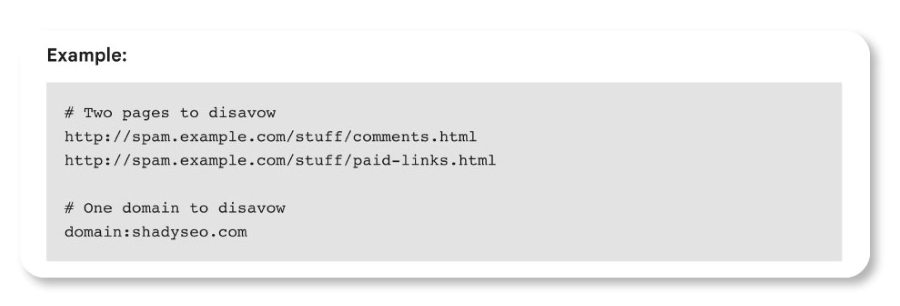
It’ll take some time to complete, but that’s all you need to do to disavow your links.
How to get more good backlinks to strengthen and improve your backlink profile
Whether you find yourself with a weak link profile or need more good links to strengthen it after you’ve cleaned and disavowed, getting good backlinks is key.
Here are some ways you can earn and obtain quality, relevant backlinks:
- Reach out to websites on a relevant niche and contribute by providing a quality guest post that adds value to their readers (and showcases your expertise in your niche)
- Publish quality research, data findings and insights and share that in the form of infographics or reports people would want to share or link back to
- Share industry insights through outreach with services like HARO, SourceBottle, industry roundups or relevant #journorequest on Twitter
- Showcase leading expertise by showing up in interviews, and local and digital press as an authority in your niche
- Get real industry awards and links from award announcements to your website
- Show up in relevant industry directories (e.g. lawyer, dental directories) or as a member of a relevant industry association
Note that while directories and citations don’t directly help with your backlink profile, they do help in boosting your local presence, improve your NAP consistency and make sure your link profile looks natural.
Key takeaways
Google wants to showcase quality, relevant content from authoritative sites at the top. You’re not going to be there (or stay there) if you try to game the system through shoddy link tactics and vendors that get you bad links.
But by developing your natural authority, you’ll find that it becomes much easier to naturally obtain good backlinks the way Google wants you to. Notice the tips shared above are all tied to building your authority and not a secret SEO hack.
Keep your link profile in top shape, and it’ll be easier for Google to understand that you’re an expert in your niche. Get natural links from authority-building practices and clean up bad backlinks.
In turn, you’ll be rewarded with much higher chances of appearing at the top of search results.

